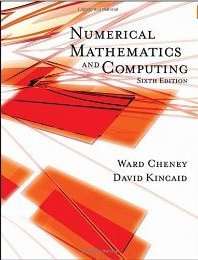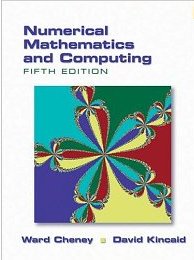


7th edition (2013)
ISBN: 1-133-10371-5
Errata
6th edition (2008)
ISBN: 495-11475-8
Errata
5th edition (2004)
ISBN: 0534389937
Errata
 |
 |
 |
| Recommended edition: 7th edition (2013) ISBN: 1-133-10371-5 Errata |
Acceptable edition: 6th edition (2008) ISBN: 495-11475-8 Errata |
Acceptable edition: 5th edition (2004) ISBN: 0534389937 Errata |
Note: This text should not be confused with another text "Numerical Analysis: Mathematics of Scientific Computing" also by Kincaid and Cheney
Office Hours
Mondays and Fridays 1:30 - 3:00pm, or at other times by appointment
Room 01A Fondren Science Building
Homework
This is a hands-on class where you learn mostly by working on the homework exercises.
Homework assignments will usually be posted on Canvas by Monday evenings and will
usually be due Monday nights by upload into Canvas.
In fairness to the students who have submitted their assignments on time,
late submissions are eligible for only 50% credit. Then once the solutions have been
posted on Canvas of course no credit can be awarded for an assignment.
Programming Tools
The Linux lab computer systems or your office computer in the Physics department,
with its gcc Gnu C compiler, can be used
to develop numerical analysis programs for assignments in this course.
However, as an alternative if you have a laptop or home computer running Microsoft
Windows you may also install the lightweight MinGW and MSys packages to develop your C programs at
home. The MinGW project home page provides more
details and documentation on the MinGW package.
Plotting Tool
We'll be making extensive use of the gnuplot plotting program
in this course. Refer to this manual for documentation.
This tool is a standard part of Linux systems, and is available on
the Physics department systems.
For those working on class assignments at home, gnuplot is also available for the Windows platform, and you may download either 32-bit Windows binary installer or 64-bit Windows binary installer and install it as well.
Some recent versions of gnuplot have arranged the default colors for the plotted curves to be some pastel, difficult to distinguish hues. To get more reasonable plot colors by default with the recent versions of gnuplot, place the lines:
set linetype 1 linecolor rgb 'red' set linetype 2 linecolor rgb 'green' set linetype 3 linecolor rgb 'blue' set linetype 4 linecolor rgb 'yellow' set linetype 5 linecolor rgb 'cyan' set linetype 6 linecolor rgb 'violet'
in a file named '.gnuplot' in your Linux home directory.
Program editing
You may use any plain text editor you feel comfortable with when working on
Linux systems, such as gedit, xemacs, nedit, vim, or others,
to compose your numerical programs.
When working on Windows, the native text editor Notepad offers very limited
capability. Two good alternatives for an enhanced editor specifically designed for
program source code are the Programmers File Editor or ViM. You
may download this executable
and install PFE simply by unzipping the contents
of this archive into a convenient directory, such as 'C:\Program Files\PFE',
and creating a shortcut in the Start Menu for the PFE32.EXE executable file.
Or downloading and running this executable will give you
a Windows installer for the ViM editor.
Back to John Fattaruso's home page